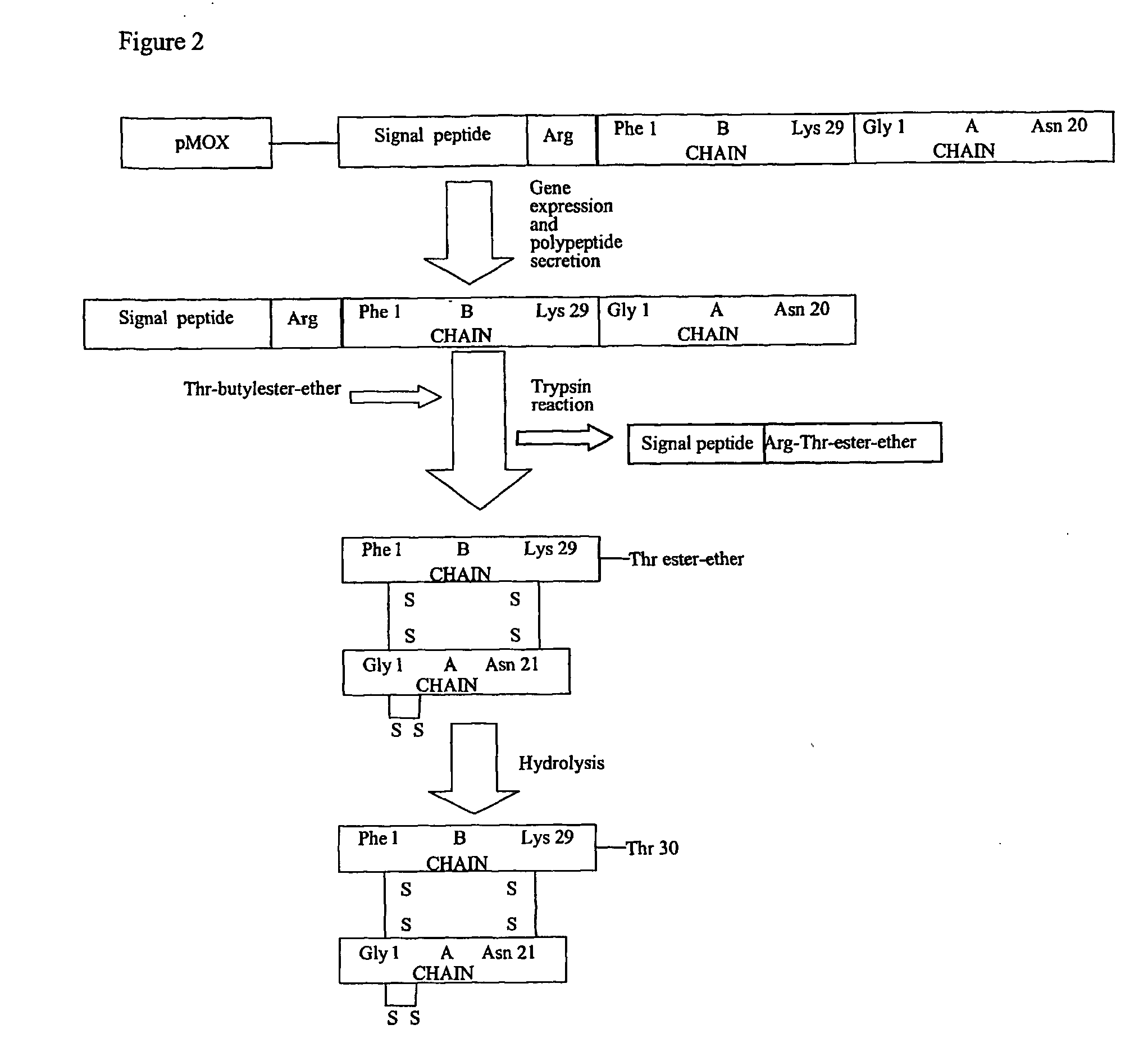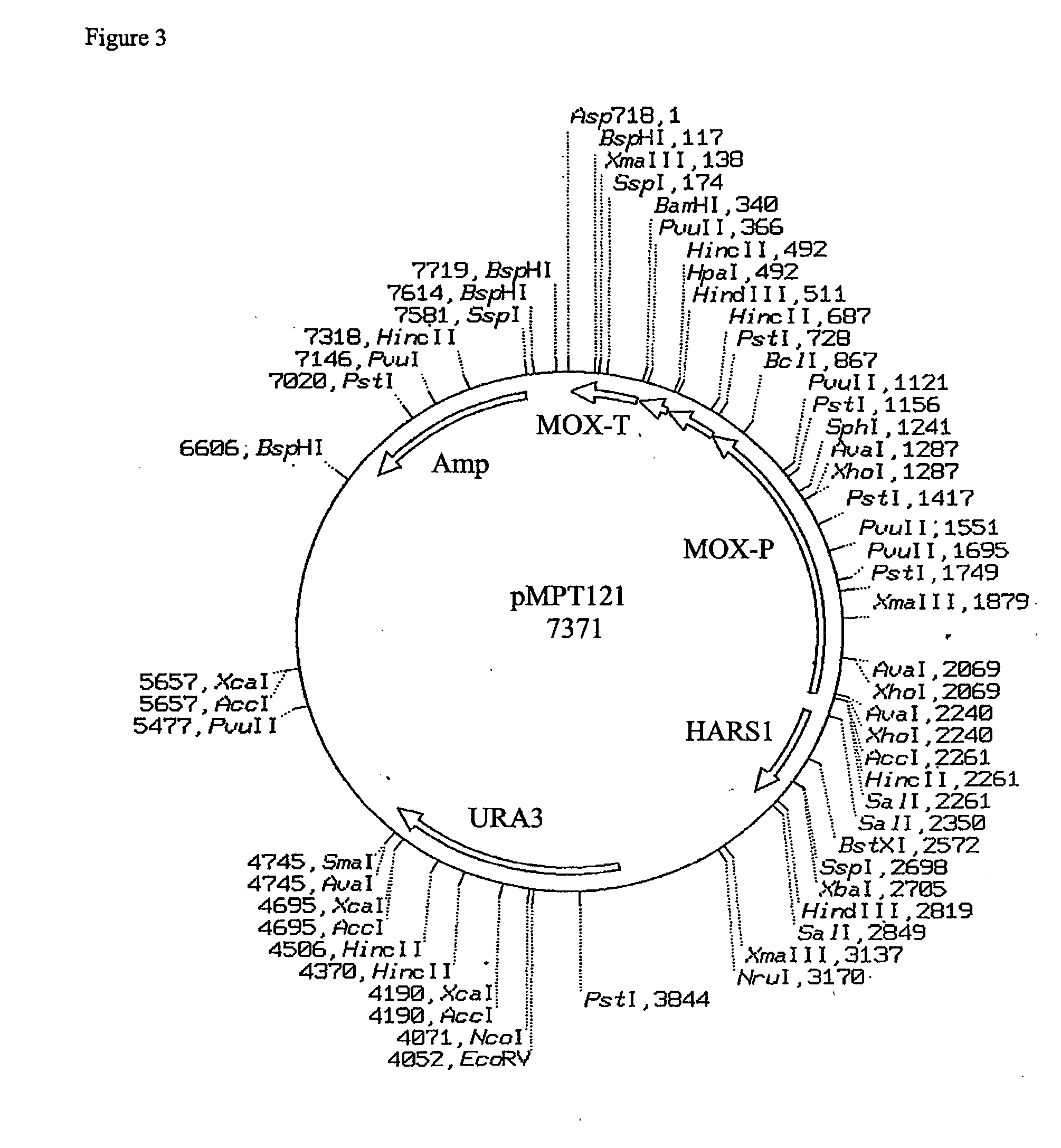Yeast protein expression secretion system
- Summary
- Abstract
- Description
- Claims
- Application Information
AI Technical Summary
Benefits of technology
Problems solved by technology
Method used
Image
Examples
example 1
Construction of the Recombinant Vector Carrying the Prepro-Polypeptides.
[0016] Seq ID 1, 2, 3 and 4 correspond to the amino acid sequences of the prepro-polypeptides InGa, InGa−, InCh, InCh−. In the case of Seq ID 1 and 2, the peptide region from amino acid 1 to 78 is the signal peptide region that ensures the secretion of the heterologous proteins. On the other hand the peptide region 79-107 of Seq ID 1 and 2 corresponds to amino acids 1-29 of the human insulin B chain, while the peptide region 108 to 128 of Seq ID 1 and 2 corresponds to amino acids 1-21 of the human insulin A chain. Similarly, in the case of Seq ID 3 and 4, the peptide region from amino acids 1-66 corresponds to the signal peptide regions, whereas the peptide region 67-116 corresponds to the insulin B and A chain regions as above. The signal peptide regions of Seq ID 1 and 2 are derived from Schwanniomyces occidentalis glucoamylase signal peptide sequence, with Seq ID 1 possessing the kex site, whereas Seq ID 2 ...
example 2
Transformation of a Yeast Strain with the Recombinant Vectors Carrying the Insulin Precursor Sequences.
[0023] The recombinant expression plasmids each carrying the oligonucleotides encoding the prepro-polypeptides InGa, InGa−, InCh, InCh−, were then transformed into the yeast strain H. polymorpha that is an ura3 auxotrophic mutant deficient in orotidine-5′-phosphate decarboxylase by methods known in the art (Hansenula polymorpha: Biology and Applications, Ed. G. Gellissen. Wiley-VCH, 2002). The resulting recombinant clones were then further used for the expression of the said polypeptides.
example 3
Expression of the Insulin Precursors in Yeast.
[0024] The yeast transformants thus obtained were then used for the expression of the insulin prepro-polypeptides InGa, InGa−, InCh, InCh−. The expression conditions were: [0025] a) Preculture: Single clones, each carrying the expression vector carrying the oligonucleotide sequences encoding the prepro-polypeptides InGa, InGa−, InCh, InCh−, were inoculated into 100 ml of autoclaved 2× YNB / 1.5% glycerol medium in a 500 ml shake flask with baffles. The composition of the 2× YNB / 1.5% is 0.28 g yeast nitrogen base, 1.0 g ammonium sulfate, 1.5 g glycerol and 100 ml water. The cultures were incubated for about 24 h at 37° C. with 140 rpm shaking until an O.D600 of 3-5 is reached. The final pH after incubation is around 2.9-3. [0026] b) Culture: 2×450 ml of autoclaved SYN6 / 1.5% glycerol media in 2×2000 shake flasks with baffles were inoculated with 20-50 ml of each of the above preculture. The cultures were then incubated for 48 h at 30° C. a...
PUM
| Property | Measurement | Unit |
|---|---|---|
| Precipitation enthalpy | aaaaa | aaaaa |
Abstract
Description
Claims
Application Information
 Login to View More
Login to View More - R&D
- Intellectual Property
- Life Sciences
- Materials
- Tech Scout
- Unparalleled Data Quality
- Higher Quality Content
- 60% Fewer Hallucinations
Browse by: Latest US Patents, China's latest patents, Technical Efficacy Thesaurus, Application Domain, Technology Topic, Popular Technical Reports.
© 2025 PatSnap. All rights reserved.Legal|Privacy policy|Modern Slavery Act Transparency Statement|Sitemap|About US| Contact US: help@patsnap.com



